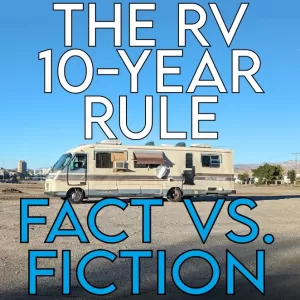 Embarking on the RV life, whether for a weekend getaway or full-time RV living, promises freedom and adventure. But before you hit the open road, it’s essential to be aware of a policy that could impact your travel plans: the RV park 10-year rule. This rule, enforced by some campgrounds, can prevent RVs older than 10 years from entering, potentially disrupting your carefully planned itinerary.
Embarking on the RV life, whether for a weekend getaway or full-time RV living, promises freedom and adventure. But before you hit the open road, it’s essential to be aware of a policy that could impact your travel plans: the RV park 10-year rule. This rule, enforced by some campgrounds, can prevent RVs older than 10 years from entering, potentially disrupting your carefully planned itinerary.
While the prospect of being turned away might seem daunting, understanding the nuances of this rule can empower you to navigate it successfully. This article delves into the reasons behind the 10-year rule, explores its prevalence and enforcement, and provides practical strategies for RVers with older rigs to ensure their RV dreams remain unrestricted. We’ll also share real-life examples of RVers who have successfully overcome this hurdle, offering inspiration and guidance for your own RV adventures.
Understanding the 10-Year Rule
The 10-year rule is a policy implemented by some RV parks to maintain a certain aesthetic and quality standard within their grounds. Essentially, it allows park operators to refuse entry to RVs older than 10 years, sometimes even if they are in pristine condition. Some parks even have a 15-year rule. This practice has sparked debate among RVers, with some seeing it as discriminatory and others understanding the business reasons behind it.
While it might seem arbitrary, the 10-year rule often stems from the desire to:
- Maintain the park’s image: Many RV parks, especially those positioning themselves as upscale resorts, strive to project an image of luxury and exclusivity. Older RVs, regardless of their actual condition, might be perceived as clashing with this image.
- Mitigate potential risks: Statistically, older RVs are more likely to experience mechanical issues, leaks, or breakdowns. Park owners might implement the rule to minimize the risk of these problems occurring on their property, which could disrupt other guests or lead to costly repairs and evictions. One campground owner shared a story about an older RV that was left abandoned after the owner had a heart attack and died while setting up camp. The ensuing legal process to remove the RV was lengthy and costly for the park.
- Address local tenancy laws: In some areas, tenancy laws make it difficult to evict long-term residents, even if they violate park rules or fail to pay rent. Older RVs might be seen as a higher risk in these situations, as they could be abandoned or neglected on the property.
- Control the types of RVs: In addition to age restrictions, some parks require an RVIA badge, which custom trailers or converted vans/buses may not have. This is another way parks try to control the types of RVs allowed in their park.
- Protect resale value: The 10-year rule can also impact the resale value of an RV, as potential buyers might be hesitant to purchase a rig that could be restricted from certain campgrounds.
However, this rule can create a barrier for RVers who prefer older, more affordable rigs, potentially making RVing less accessible for those on a budget.
Prevalence and Enforcement
The good news is that the 10-year rule is not as widespread as some might believe. Many RV parks, especially public campgrounds and those affiliated with larger networks like KOA, do not have such restrictions. KOA, the world’s largest network of privately-owned campgrounds, has franchises in 47 states and 9 Canadian provinces. These campgrounds typically offer more amenities and well-maintained facilities.
Even in parks with the 10-year rule, enforcement varies significantly. Some strictly adhere to it, while others use it more as a guideline, primarily to exclude RVs that are visibly dilapidated or in poor condition.
Here’s a table summarizing the factors that can influence the enforcement of the 10-year rule:
| Factor | Description |
|---|---|
| Location | The rule is more common in popular tourist destinations and upscale RV resorts, particularly in Florida and Arizona. |
| Time of year | Parks might be more lenient during the off-season when they have more vacancies. |
| Length of stay | The rule is more frequently applied to monthly stays, long-term stays, or permanent residents. |
| RV’s condition | Ultimately, the deciding factor is often the RV’s appearance and perceived state of repair. |
Examples of Successful Appeals
Many RVers with older rigs have successfully navigated the 10-year rule by being proactive and demonstrating their RV’s good condition.
- One RVer with a 2002 motorhome shared that they have always been approved after sending photos of their well-maintained RV to parks with the 10-year rule.
- Another RVer reported that their 20-year-old travel trailer was accepted at a campground after providing a safety inspection report and recent photos.
- In an online forum, several RVers shared their experiences of staying at parks with the 10-year rule after sending photos of their clean and updated RVs.
- We too have been subjected to the 10 year rule, but like others, all we had to do was submit current pictures to the RV park management.
These examples illustrate that the 10-year rule is not always an insurmountable obstacle. By taking proactive steps and showcasing your RV’s condition, you can increase your chances of enjoying your travels without restrictions.
Getting Around the 10-Year Rule
If you own an RV that’s older than 10 years, don’t let this rule discourage you from exploring your favorite destinations. Here are some strategies to increase your chances of getting your older RV approved:
- Maintain your RV meticulously: Keep it clean, well-maintained, and in good working order. Address any visible signs of wear and tear, such as faded paint, peeling decals, or damaged trim.
- Consider alternative campgrounds: If a particular park strictly enforces the 10-year rule, explore alternative options in the area, such as public campgrounds, those without age restrictions, or platforms like Harvest Hosts.
- Communicate proactively: If you’re unsure about a park’s policy, call them directly and explain your situation. A friendly conversation and assurance that your RV is well-maintained might sway their decision.
Appealing the 10-Year Rule
If a campground has a 10-year rule, be prepared to appeal it by providing evidence of your RV’s good condition. Here are some tips:
- Provide recent photos: When making a reservation, offer to send recent photos of your RV to the park management. This allows them to assess its condition and potentially grant an exception.
- Highlight any upgrades or renovations: If you’ve invested in upgrades or renovations that enhance your RV’s appearance or functionality, be sure to mention them.
Conclusion
The RV park 10-year rule is a reality for owners of older RVs, but it doesn’t have to signify the end of your RVing adventures. By understanding the reasons behind the rule, being proactive in your communication, and maintaining your RV in excellent condition, you can overcome this potential obstacle and continue to enjoy the freedom of the open road.
While the rule aims to uphold park standards and mitigate risks, it can also create a barrier to affordable RVing. However, it’s important to remember that the 10-year rule is often a guideline rather than a strict policy. By taking the steps outlined in this article, you can increase your chances of getting your older RV approved and continue to create unforgettable memories on the road.
We’d love to hear about your experiences with the 10-year rule! Share your stories and tips in the comments.

